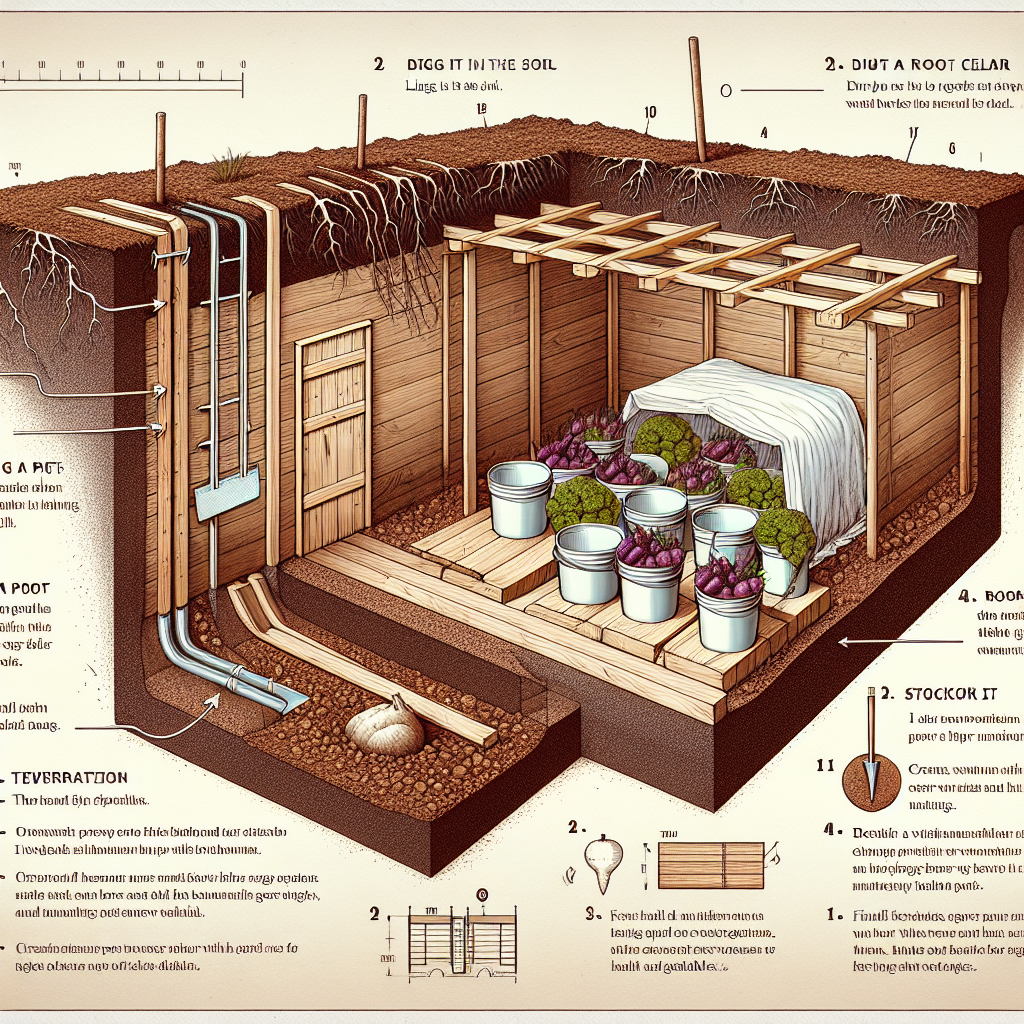
How to build a root cellar
Understanding the Importance of a Root Cellar
In an era where sustainability and self-sufficiency are becoming increasingly important, many individuals are turning to traditional methods for storing food. One fascinating method that is often overlooked is the use of a root cellar. A root cellar is an underground storage facility that effectively preserves fruits, vegetables, and other perishables by maintaining a stable temperature and humidity level. Not only does this method extend the shelf life of your produce, but it also promotes a healthier lifestyle by reducing reliance on processed foods.
What is a Root Cellar?
A root cellar is typically a cool, dark, and humid space located below ground level or built into a hillside. This environment mimics the natural conditions that root vegetables and fruits need to stay fresh for long periods. While traditionally used for root vegetables such as potatoes, carrots, and beets, root cellars can be adapted for a variety of foods, making them versatile storage solutions for gardeners and food enthusiasts alike.
The Benefits of a Root Cellar
Building a root cellar can provide several advantages, including:
- Preservation of seasonal produce well into colder months.
- Reduction of food waste by prolonging the life of fruits and vegetables.
- Lowered energy costs as you won't need refrigeration for stored foods.
- Potential for year-round access to fresh produce.
- Encouragement of sustainable living practices.
How to Build a Root Cellar
Creating your own root cellar may seem like a daunting task, but with proper planning and consideration, it can be a rewarding project. Here, we outline the essential steps to facilitate the construction of your own root cellar.
Step 1: Choose the Right Location
One of the most critical aspects of building a root cellar is selecting an appropriate site. Consider the following factors:
- **Temperature**: Ideally, choose a location that remains cool year-round, ideally below 50°F (10°C).
- **Drainage**: Ensure the site has good drainage to prevent water accumulation.
- **Accessibility**: The cellar should be easily accessible for transporting food in and out.
- **Space**: Consider the amount of produce you wish to store and choose a location that will accommodate it.
Step 2: Determine the Size and Structure
The size of your root cellar will depend on your storage needs. However, it’s essential to consult local building codes and zoning regulations before beginning construction. Common structures for root cellars include:
- **Earth-sheltered cellars**: Dug directly into the ground
- **Cinderblock or concrete cellars**: Built above ground and often include provisions for humidity control
- **Repurposed spaces**: Utilizing old basements or sheds
Step 3: Excavation and Construction
Once you’ve finalized your location and structure type, you will need to excavate the area to create your cellar. Here are important construction considerations:
- **Digging**: Excavate the soil to your desired depth, typically 4-10 feet.
- **Ventilation**: Install ventilation to regulate temperature and humidity levels.
- **Flooring**: Use gravel or concrete for the floor to facilitate drainage.
- **Walls**: Build up walls using structural materials of your choice, ensuring insulation and protection against moisture.
- **Entrance**: Plan an entrance that can be sealed to maintain the ideal environment inside the cellar.
Step 4: Temperature and Humidity Control
Maintaining the right conditions inside your root cellar is crucial. Here are some tips for controlling temperature and humidity:
- **Thermometers and hygrometers**: Place these devices inside the cellar to monitor conditions.
- **Ventilation**: Regularly adjust the ventilation to allow for fresh air circulation while preventing moisture buildup.
- **Humidity control**: If humidity is too low, you can use water trays or damp cloths, while too much humidity can be dealt with by improving airflow.
Step 5: Organizing and Storing Produce
After building your root cellar, it's time to start storing your produce. Here are some effective storage tips:
- **Use wooden crates or bins**: These help prevent bruising and allow for air circulation.
- **Separate produce**: Store fruits and vegetables separately to avoid premature ripening.
- **Label everything**: Keep track of what you've stored by labeling bins and crates.
Maintenance Tips for Your Root Cellar
To ensure the longevity of your root cellar and the quality of the produce stored within, consider the following maintenance guidelines:
- **Inspect regularly**: Check for signs of rot or spoilage and remove affected items promptly.
- **Control moisture levels**: Monitor humidity and adjust ventilation as necessary.
- **Seal any openings**: Regularly inspect for cracks or openings that may allow unwanted pests or moisture.
Understanding What to Store in Your Root Cellar
Not everything can be stored indefinitely in a root cellar. Here is a list of items that do well in this environment:
- Root vegetables (potatoes, carrots, beets)
- Fruits (apples, pears)
- Onions and garlic
- Cabbage and other hardy greens
- Winter squash and pumpkins
Conclusion
Building a root cellar can be a fantastic way to preserve your harvest and enjoy seasonal produce year-round. By following the steps outlined above, you can create an efficient and effective root cellar tailored to your needs. Embracing this traditional method not only enhances your self-sufficiency but also contributes to a simpler and more sustainable lifestyle.
“A well-built root cellar is an investment not just in food preservation, but in the sustainability of our food systems.” – Food Preservation Expert
Whether you're an experienced gardener or just starting out, understanding how to build a root cellar and maintaining it efficiently can yield great benefits in both nutrition and enjoyment of your homegrown produce. Start your journey today and embrace the age-old practice that harmonizes with nature and your health!
By Guest, Published on August 7th, 2024